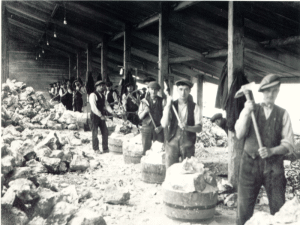|
|
William's
purchases constituted the original Beacon Hill Plaster Works,
also known as The Great Northern Plaster Works. Beacon Hill
forms an outcrop to an extensive deposit of gypsum and it was this
outcrop which was worked.
| It
appears that his initial interest was in the boiler works, but once
at Newark, and familiar with the growing plaster trade, he
concentrated on the gypsum side of the business. Nevertheless,
Cafferata’s did for many years produce boilers, mostly at a loss.
The last Cafferata boiler known to have been operating was one of a
pair, scrapped in 1920, in the Old
Mill at Cafferata’s plant at Newark.Although
part of the area bought by William Cafferata was virgin ground, a
quarry had been established. The top rocks,
the Cocks and Hens, were extracted by digging a hole about
15 ft. square, installing timbering, and digging out the
rock,
found in large swells. When one swell, which could be up
to 15 ft. thick, was exhausted, the hole would be filled
and
the quarrymen would move to another swell. |
 |
|
Gypsum Miners in
Newark
|
Reaching
the lower
rock was more precarious. The quarrymen would find a foothold
and cling to the quarry face, would drill a hole
with a chisel, put in a tot of blasting powder, tamp this
down with clay, then blow it with a straw fuse. The accident rate is not
recorded, although the quarrymen added rough rock climbing to their more
traditional skills. All
the rock, together with the overburden, would be blown to
the bottom of the quarry, where it was separated, the overburden being
spread around the lower slopes of the quarry, the gypsum rock being
carried by winches to the plant.
|
|
|
At
the plant, not far from the Beacon Hill quarry, the gypsum
would be manufactured into baked plaster in bakers'
ovens. The ovens would be raised to red heat in the
early hours of the morning, then, when judged hot enough,
about
two or three tons of the gypsum would be rolled in by hand, in lumps
about six or eight inches cube, and left there
for 18 hours. It was then dragged out on 'peels',
or long-handled shovels, and on to the edge runners. This
process remained the same for many years. It is said that in later
years, Cafferata's produced a breed of lawn bowlers
that could not be beaten, so skilled were they at lobbing
lumps of gypsum into exact places in the ovens,
of which ultimately a dozen were in
operation.
In
1864 William Cafferata built a mineral mill, with burr-stones
and centrifugal dressers, that had been patented. The
elaborate patent and huge wax seal was, at one time, owned by
William's
great-grandson, Gerald. The mill drive steam engine was
extraordinary for the times, the cylinders revolving round the
crankshaft. It had, however, a lack of balance,
and was eventually replaced by a big Yates and Thorn engine,
driven by an 18 ft. flywheel and a broad belt. A gruesome
legend tells that a cat, chased by a dog, was once flattened
on
this belt.
The
brickyard was producing 30,000 bricks a week. They were
not especially satisfactory. Unless burnt very hard, they
would retain their granular structure and could not stand
up
to the weather. Even so, many houses in Newark can still
be
seen with bricks from this period. |
|
|